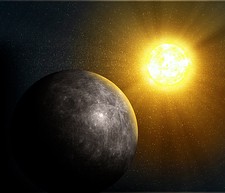
Mercury: Scorched by Day, Frozen by Night
Mercury, the smallest and swiftest planet in our solar system, lives up to its namesake, the Roman messenger god, by zipping around the Sun at breakneck speed. However, unlike the god known for swift travel and communication, this tiny world is a place of extremes – scorching hot days and bone-chilling nights.
A Fiery Furnace
Mercury holds the dubious honor of being the closest planet to the Sun. At a scorching 430°C (800°F) during the day, the surface temperature on Mercury is hot enough to melt lead. But don't be fooled by the heat – Mercury has no atmosphere to speak of. This thin exosphere offers no insulation, so as soon as the Sun dips below the horizon, temperatures plummet to a frigid -180°C (-292°F). Imagine a world where you could fry an egg on the sidewalk during the day and need a parka at night – that's Mercury!
A World Scarred by Time
The relentless bombardment of micrometeoroids and asteroids over billions of years has left its mark on Mercury's surface. The planet is heavily cratered, resembling Earth's Moon in its battle-worn visage. One particularly impressive crater, the Caloris Basin, is a whopping 1,550 kilometers (960 miles) wide – large enough to swallow a small country!
A Day Longer Than Its Year
This is where things get interesting. Mercury's rotation is peculiar. It takes longer for Mercury to complete a single rotation on its axis (59 Earth days) than it does to orbit the Sun (88 Earth days). This means the Sun rises very slowly on Mercury, taking nearly two Earth days. As a result, some parts of the planet experience scorching sunlight for extended periods, while others remain in perpetual darkness for months.
A World of Mystery
Despite its proximity to Earth, Mercury remains a mysterious world. The harsh conditions make it a difficult target for spacecraft, and our visits have been brief. However, recent missions like MESSENGER by NASA and BepiColombo by a joint European-Japanese team are starting to peel back the layers of this enigmatic planet.
The Future of Mercury Exploration
Future missions to Mercury aim to unlock its secrets. Scientists are particularly interested in understanding why Mercury has such a large iron core and a thin atmosphere. Studying Mercury may also provide clues about the formation of the solar system's rocky planets, including our own Earth.
So, the next time you gaze up at the night sky, take a moment to consider the tiny speck of light that is Mercury. This world, though seemingly harsh and desolate, holds the key to unlocking the mysteries of our solar system's formation and evolution.
0 comments
Be the first to comment!
This post is waiting for your feedback.
Share your thoughts and join the conversation.
